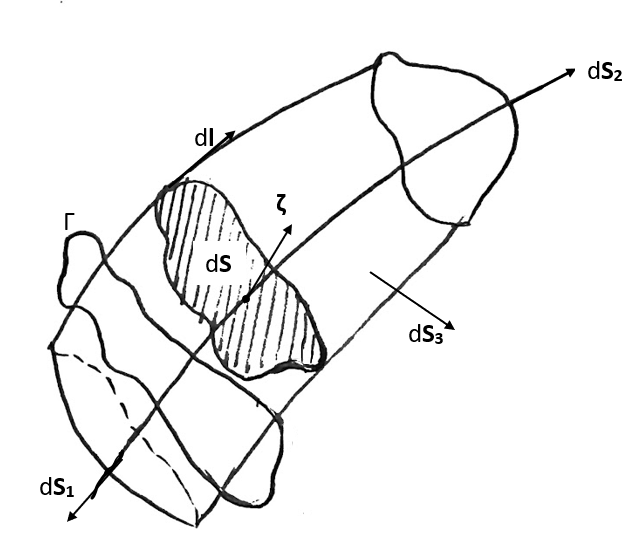Kelvin’s Circulation Theorem
Circulation is defined as
\[\begin{aligned} \Gamma &= \oint \vec{U}\cdot\vec{\operatorname{d}l}. \end{aligned}\]
where \(\Gamma\) is the circulation, \(\vec{U}\) is the velocity and the integral is over any closed curve in the flow domain.
Concept of circulation was first introduced by William Thomson, \(1^{st}\) Baron Kelvin and he also stated the theorem published in 1869.
Kelvin’s circulation theorem states that
In an inviscid, barotropic flow with conservative body forces, the circulation around a closed curve moving with the fluid remains constant with time.
Or,
\[\Dt{\Gamma} = 0.\]
Note that it is not \(\frac{d}{dt}\) but rather that Lagrangian/substantial/total derivative
\[ \Dt{()} = \pt{()} + \vec{U}\cdot\nabla (). \]
Proof:
Clearly,
\[ \Dt{\Gamma} = \Dt{} \oint\limits_c \vec{U}\cdot\vec{\operatorname{d}l} = \oint\limits_c \Dt{(\vec{U}\cdot\vec{\operatorname{d}l})} = \oint\limits_c \left[ \Dt{\vec{U}}\cdot\vec{\operatorname{d}l} + \vec{U}\cdot\Dt{(\vec{\operatorname{d}l})} \right].\]
Since,
\[ \Dt{(\vec{\operatorname{d}l})} = \lim_{\Delta t \to 0} \frac{\vec{\operatorname{d}l'}-\vec{\operatorname{d}l}}{\Delta t} = \operatorname{d}\vec{U}, \]
we have,
\[ \Dt{\Gamma} = \oint\limits_C (\Dt{\vec{U}}\cdot\vec{\operatorname{d}l} + \vec{U}\cdot \operatorname{d}\vec{U}) = \oint\limits_C \Dt{\vec{U}}\cdot\vec{\operatorname{d}l} + \oint\limits_C\frac{\operatorname{d}|\vec{U}|^{2}}{2}. \]
As
\[\ \ \oint\limits_C\frac{\operatorname{d}|\vec{U}|^{2}}{2} =0,\ \ \text{and}\ \ \Dt{\vec{U}} = -\frac{\nabla p}{\rho} \ \text{(Momentum Conservation)} \]
we have,
\[\Dt{\Gamma} = -\oint\limits_C\frac{\operatorname{d}p}{\rho}. \]
For a general flow, the closed integral cannot be evaluated.
Recall that a barotropic flow is a flow where density is a function of pressure alone. Hence, for a barotropic flow, \(\rho = f'(p)\). Then
\[ \Dt{\Gamma} = -\oint\limits_C f'(p) \operatorname{d}p = 0. \]
Now let us consider flows that are barotropic.
Incompressible flow \(\rho = \text{constant}\).
Isentropic compressible flow \(\p/\rho^{\gamma} = \text{constant}\).
Isothermal compressible flow \(\p/\rho = \text{constant}\).
Therefore, in an inviscid incompressible flow, the circulation around a closed curve moving with the fluid remains constant with time. If a freestream exists, then there is a region in the flow that is irrotational, i.e. \(\Gamma = 0\). Hence, an inviscid incompressible flow with a freestream is irrotational.
Similarly, an isentropic compressible flow with a freestream is also irrotational. Whether a flow is isentropic or not can be determined by deriving the entropy equation and checking the conditions under which the entropy remains constant.
Circulation plays a pivotal role in aerodynamics for calculation of lift.
Q: Why is Kelvin’s circulation theorem required?
It seems at first glance that the Kelvin’s circulation theorem is another form of the Stokes’ theorem. So why is it required?
( Typeset by Swetha Lakshmi S (IIST AFM MTech 2022) )
